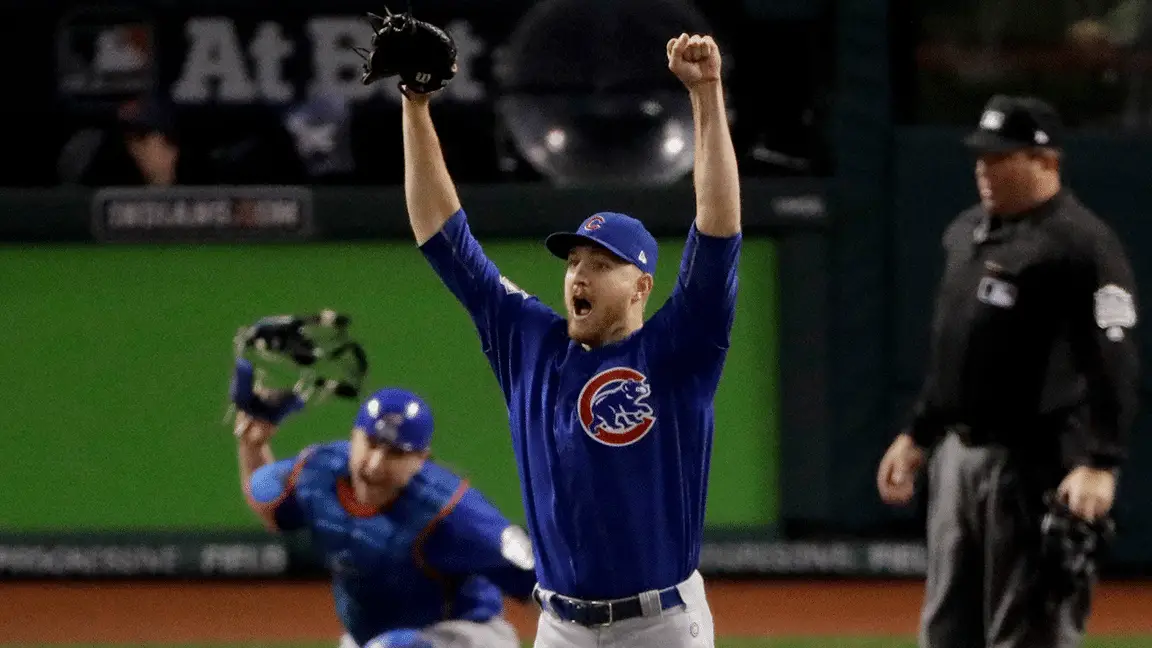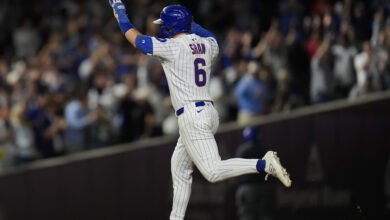
Mike Montgomery’s Lights-Out Stuff Better Suited for Pen than Rotation
No matter what happens over the rest of his career, Mike Montgomery will forever be the answer to the trivia question: “Who was on the mound when the Cubs won their first world series in, like, a long time?” Prior to that, he was known as the guy the Cubs got in return for Dan Vogelbach. Shortly after arriving in Chicago, however, he gave up runs in his first three appearances and earned a moniker that saw his initials go from MM to MF.
But he followed that up by wrapping nine consecutive scoreless relief appearances around five spot starts late in the season and got his proper name back. Montgomery’s postseason performance (5 ER in 13 IP) left a little to be desired, though the numbers give us scant insight into the individual situations of his 11 appearances.
Consider Game 3 of the NLDS, in which the lefty took the ball with the score tied at 5 in the 9th inning. Montgomery ended up taking the loss, but only after gutting out 4 scoreless innings to get the Cubs to the 13th. He then gave up 3 earned runs over his next three outings (2.1 IP), followed by no earned runs over the three subsequent appearances (4.2 IP). He looked rough in Game 4 of the World Series before closing the season on a high note.
Pretty nice capper for a guy who posted a 2.82 ERA and .214 batting average against over 38.1 innings as a swingman. Of course, he’s also the guy whose 1.30 WHIP as a Cub would have ranked 88th among relievers and 45th among starters (a spot occupied, interestingly enough, by Trevor Bauer) in 2016. Sorry, I’m droning on here.
Those numbers above represent a significant departure from Montgomery’s full-season marks of 2.52 and 1.17, shifts that can be at least partially attributed to the shock of being traded. Given the high-leverage experience and an increased comfort level with his team new team and city, there’s every reason to believe the southpaw can be significantly better next season. Pitching performance is about more than just emotion and feel, though, you’ve still got to be able to leverage your stuff.
Mike Montgomery has two top 25 non fastballs by whiffs and grounders. Last time I saw this on a reliever, it was Carlos Carrasco.
— Eno Sarris (@enosarris) January 3, 2017
Those two non-fastballs are the change and cutter, offerings Montgomery has served up with a great deal more efficacy than I ever would have guessed. According to PITCHf/x, the cutter generated a 27.84 percent whiff rate that ranked 21st among all pitchers (min. 100 pitches) in 2016. That same pitch induced a very nice ground-ball rate of 69 percent, third in MLB. And the change was a few ticks better, getting a third-ranked 54.43 percent whiff rate and an 11th-ranked 67 percent ground-ball rate.
The lefty’s career numbers on the these pitches are even more impressive when viewed in light of his peers and predecessors. Among all pitchers for whom PITCHf/x has data (since 2007; min. 200 pitches), the 45.66 percent whiff rate Montgomery’s gotten on the change ranks 19th. And the cutter? That one ranks 23rd with a 31.78 percent whiff rate. What’s more, Montgomery actually sits at the top of the list — again, this is for both starters and relievers — with a 70 percent ground-ball rate.
So, yeah, that’d be a pretty nice asset for the rotation. If Montgomery’s able to make his stuff play as a starter, that is.
Over a limited sample last season, he allowed a slash line of .188/.303/.405 with a 3.33 ERA (5.04 FIP) and 1.15 WHIP. Not bad, though the disparity in ERA and FIP is a little concerning. What’s more, Montgomery gave up home runs in four of his five starts and struck out only 24 while walking 12 over that stretch. In case you were wondering, the average K/BB ratio for starters is 2.62 and a mark of 2.00 would have been tied with Rob Zastryzny for 200th in MLB. Not exactly indicative of greatness, but, you know, only 24.1 innings and whatnot.
Beefing up the sample by pulling in the numbers from his days in Seattle doesn’t help to form strong case for Montgomery as a starter. After tossing back-to-back complete-game shutouts in his fifth and sixth career starts, things got pretty ugly. Montgomery notched a 7.49 ERA over his final 10 starts and finished his Mariners tenure with a 4.44 ERA over 101.1 innings pitched. He wasn’t exactly a world-beater in eight minor league seasons, either, having never logged better than a 4.29 ERA at AA or higher.
We could look at all that and see the bright side, maybe assume that Montgomery just took a while to push the boulder up his personal learning curve. Perhaps, like Jake Arrieta, he just needed a change of scenery and a little freedom to do his thing. Or maybe we see a guy who, at 27 years old, has shown us what he is as a starting pitcher. Please understand that I don’t mean that as a knock. He could be cut from the same cloth as Andrew Miller, a pitcher who only realized his full potential when he was moved to the bullpen for good.
Taking all this into account, I tend to lean toward the latter of those assessments. Not that Montgomery is on Miller’s level or anything, just that I feel he presents the most value to the Cubs when working in shorter stints more frequently than every fifth day. I don’t doubt for a second that the guy can be a decent starter, I just question his stamina and think he can be an excellent reliever. When I posited such on Twitter, I was asked whether I’d prefer 175 good innings or 75 great ones. Swap out dimes and quarters for good and great in that question, you’ll get a yes from me all day.
While that analogy is perhaps a bit raw and assumes fixed valuations that aren’t directly related to any empirical data, I think you understand where I’m going here. During his time as a starter, Montgomery has allowed a .774 OPS the first through the lineup and a .905 the second time through. And he has given up a .663 OPS on pitches 1-25, but an .830-something OPS on pitches 26-75. Hey, wait a minute: quarter, good performance over first 25 pitches. Maybe I’m onto something.
Of course, Montgomery’s eventual deployment and the value he can bring to the team comes down to the rest of the personnel on the roster and what makes the most sense. Absent any further moves, that probably means maintaining his clubhouse lead on the fifth spot in the rotation. Maybe even the fourth. It’d be a different story should the Cubs add another proven starter. I’d like to hearken back to those pitch stats from earlier and ask whether you might wanna venture a guess as to whose 68 percent ground-ball rate on the cutter sits just behind Montgomery? Yep, you got it: Tyson Ross.
If the Cubs land Ross, it likely means Montgomery working as part of a six-man unit and/or transitioning back to the pen. And you have to assume the rotation will experience somewhat less than the nearly injury-free campaign it enjoyed in 2016, which means spot-start duties. It’s absolutely understandable to see the results Montgomery has generated from the cutter and change and salivate over what could be in a bigger role. And it’s equally understandable to see that the lefty’s overall results leave him best suited to play the role of primary lefty reliever and gap-filler.
Regardless of how he ends up getting his innings, Montgomery’s greatest asset is that he’ll do so on a rookie contract. Because it took so long for the lanky lefty to break through, his limited service time means that he’s not even arbitration-eligible until 2019 and won’t be a free agent until 2022. That sets a pretty low bar for the type of performance required from him in order to earn his keep and it also gives the Cubs all kinds of room when it comes to making other moves.
Not a bad spot to be in, all things considered. And, having considered all things, I think the best spot for Mike Montgomery is under the bleachers in the relocated bullpen.


